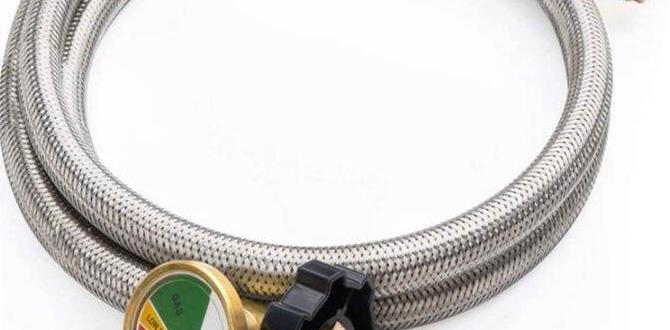Solar chargers are a smart, eco-friendly way to keep your doorbell powered up without constant battery changes. They harness sunlight to maintain a steady charge, ensuring your doorbell is always ready to alert you. This simplifies doorbell maintenance and provides reliable security.
Solar Charger: Essential Power for Doorbells
Tired of your smart doorbell losing power and missing important visitors? It’s a common frustration. You get notifications that your battery is low, and soon your doorbell is offline, leaving you in the dark. This can feel like a hassle, especially when you rely on your doorbell for security and convenience. The good news is, there’s a simple, sustainable solution: a solar charger. It’s like giving your doorbell its own personal sunshine power-up. We’ll walk you through exactly how a solar charger works and why it’s a great choice for keeping your doorbell running smoothly, ensuring you never miss a moment at your doorstep.
Imagine never having to climb a ladder to swap out batteries again. That’s the promise of a solar charger for your smart doorbell. It’s an easy way to keep your device charged and ready, using clean energy from the sun. We’ll break down how these handy gadgets work, what you need to know before buying one, and how to set it up. Let’s dive in and make sure your doorbell is always powered and protecting your home.
Why Choose a Solar Charger for Your Doorbell?
Smart doorbells are fantastic tools for home security and convenience. They let you see, hear, and speak to visitors from anywhere. But they come with a catch: they need power. Most rely on rechargeable batteries, which, while better than disposable ones, still need to be recharged or replaced periodically. This is where solar chargers step in, offering a brilliant, hands-off solution.
The Convenience Factor
The biggest draw of a solar charger is its incredible convenience. Once set up, it continuously trickles power into your doorbell’s battery. This means fewer trips up a ladder, less worry about dead batteries, and more consistent performance from your doorbell. You can set it and essentially forget it, enjoying uninterrupted peace of mind.
Environmental Benefits
By using solar energy, you’re tapping into a renewable resource. This reduces your reliance on grid electricity and minimizes your carbon footprint. It’s a small change that contributes to a larger, greener future, making your home security more sustainable.
Cost Savings Over Time
While there’s an initial investment for a solar charger, it can save you money in the long run. You won’t need to buy replacement batteries as often, and you’ll save on electricity costs that would otherwise be used for charging. For busy households, the time saved on maintenance is also a valuable benefit.
How Do Solar Chargers Work for Doorbells?
The concept is simple, but the technology is clever. A solar charger for a doorbell is essentially a small solar panel designed to capture sunlight and convert it into electrical energy. This energy is then used to keep your doorbell’s battery topped up.
Here’s a breakdown of the process:
- Solar Panel: The panel contains photovoltaic (PV) cells. When sunlight hits these cells, it excites electrons, generating a direct current (DC) electricity.
- Charge Controller (often built-in): This mini-circuit manages the flow of electricity from the solar panel to the doorbell’s battery. It prevents overcharging, which can damage the battery and shorten its lifespan. It ensures the battery receives the right amount of power.
- Connection to Doorbell: The solar charger connects to your doorbell’s charging port, usually via a USB cable or a dedicated connector.
The continuous trickle charge means that on sunny days, the charger might even keep the battery fully powered, while on cloudy days, it will still provide some power, significantly extending the time between manual recharges.
Choosing the Right Solar Charger for Your Doorbell
Not all solar chargers are created equal, and selecting the right one for your specific doorbell is crucial. Here’s what you should consider:
Compatibility
This is the most important factor. Ensure the solar charger is designed to work with your specific doorbell model or brand. Many brands offer their own proprietary solar chargers, while some universal options exist. Check the product description carefully for compatibility lists.
Panel Size and Wattage
Larger panels with higher wattage can generate more power. In areas with less direct sunlight or for doorbells that consume more power (e.g., frequent motion detection, longer video recordings), a more powerful panel is recommended. Most doorbell solar chargers range from 2W to 5W.
Weather Resistance
Your solar charger will be outdoors, exposed to the elements. Look for chargers with a high IP (Ingress Protection) rating, indicating good resistance to dust and water. Materials like durable plastics and sealed connectors are signs of quality.
Mounting Options
Consider how the charger will be mounted. Does it come with an adjustable mount? This allows you to angle the panel to face the sun optimally. Some chargers have a fixed mount, while others offer more flexibility. Think about the best spot for your doorbell and if the charger can be positioned there.
Cable Length
The length of the power cable is important. You need to place the doorbell in a good spot for security and visibility, but the solar panel might need to be in a sunnier location. Measure the distance to ensure the cable is long enough. For instance, some doorbells might be on a shaded porch, while the best
sunlight is available a few feet away.
Installation and Setup Guide
Setting up a solar charger is generally straightforward, designed for DIY installation. Here’s a typical step-by-step process:
Step 1: Charge Your Doorbell Battery First
Before connecting the solar charger, it’s a good practice to fully charge your doorbell’s battery using its original charger. This ensures the battery starts with a healthy charge, allowing the solar charger to maintain it effectively from the beginning.
Step 2: Position the Solar Panel
Identify the location with the most direct sunlight throughout the day for your front door area. Ideally, this means a south-facing position (in the Northern Hemisphere) that receives at least 4-6 hours of direct sunlight daily. Avoid placing it where it will be shaded by trees, eaves, or other obstructions.
Step 3: Mount the Solar Panel
Use the provided mounting hardware or bracket. Most solar chargers come with screws and anchors. If mounting on wood, screws are usually sufficient. For brick or concrete, you’ll need to drill holes and use wall anchors. If the mount is adjustable, position it to face the sun directly. Many mounts allow you to swivel and tilt the panel.
Tools you might need:
- Drill with appropriate drill bits (for brick/concrete)
- Screwdriver
- Pencil for marking
- Level (optional, but helpful)
Step 4: Connect the Solar Charger to Your Doorbell
With the solar panel mounted, connect the charging cable to your doorbell. Most modern smart doorbells have a dedicated charging port, often located on the back or bottom. Ensure the connection is secure. The doorbell should indicate that it’s receiving a charge, though it might not show a rapid charging icon as it would with a wall charger, since solar is typically a trickle charge.
Step 5: Test and Monitor
Check your doorbell’s app in a few hours or the next day. It should show the battery level, and ideally, it will be maintaining or slowly increasing. You might need to check the connection and panel positioning if you don’t see any charging activity.
Safety Tip: Always follow the specific instructions that come with your solar charger and doorbell. If you are uncomfortable with drilling or mounting, consider asking a friend or a professional for help.
When to Consider a Solar Charger
A solar charger is a fantastic addition for many smart doorbell users. Here are a few scenarios where it shines:
- Frequent Battery Drain: If your doorbell consistently chews through battery power due to high traffic, frequent alerts, or poor Wi-Fi signal.
- Difficult Access: If your doorbell is installed high up or in a hard-to-reach spot, making manual charging a chore.
- Desire for Sustainability: If you’re looking for eco-friendly ways to power your home devices.
- Consistent Sunlight: If your installation location receives a good amount of direct sunlight most days.
If your doorbell is in a perpetually shaded spot or you live in a region with very little sunlight year-round, a solar charger might not be sufficient on its own and could only delay the inevitable need for manual charging.
Pros and Cons of Using a Solar Charger
Like any technology, solar chargers have their advantages and disadvantages. Understanding these will help you make an informed decision.
| Pros | Cons |
|---|---|
| Continuous Power: Keeps the battery topped up without intervention. | Sunlight Dependent: Performance relies heavily on sunlight availability. Cloudy days or shaded areas reduce effectiveness. |
| Convenience: Eliminates the need for frequent manual charging or battery swaps. | Initial Cost: Requires an upfront purchase. |
| Eco-Friendly: Uses renewable solar energy, reducing carbon footprint. | Theft Risk: External panels can be targets for theft, though many are designed to be tamper-resistant. |
| Cost Savings: Reduces spending on electricity and replacement batteries over time. | Aesthetics: An extra panel on your wall might not appeal to everyone’s sense of home design. |
| Extended Battery Life: Consistent charging can sometimes be gentler on batteries than deep discharge cycles. | Potential for Damage: Outdoor placement means exposure to extreme weather, though most are built to withstand this. |
Understanding Doorbell Battery Types and Charging Needs
Most smart doorbells use rechargeable lithium-ion batteries. These batteries are popular because they hold a good charge, are relatively lightweight, and can be recharged many times. However, like all batteries, they have a lifespan and perform best within certain charging parameters.
Doorbell manufacturers recommend specific charging methods to ensure battery health and longevity. Overcharging can degrade lithium-ion batteries faster. Fortunately, most modern chargers, including solar ones, have built-in protection circuits to prevent this. A solar charger’s advantage is its constant, low-level charging (trickle charge), which is often ideal for maintaining lithium-ion batteries without stressing them.
It’s also worth noting that extreme temperatures – both hot and cold – can affect battery performance and charging speed. While the doorbell itself has some thermal management, the battery might drain faster in very cold weather. A solar charger can help mitigate this by continuously pushing power into the battery.
Optimizing Solar Charger Performance
To get the most out of your solar charger, a few smart practices can make a big difference:
- Angle is Everything: Adjust the solar panel’s angle to face the sun directly. In the Northern Hemisphere, this generally means pointing it south. You might need to adjust the angle seasonally as the sun’s path changes. A good starting point is to tilt it so it’s perpendicular to the sun’s rays at midday.
- Keep it Clean: Dust, dirt, pollen, or bird droppings on the solar panel can significantly reduce its efficiency. Wipe the panel clean with a damp cloth periodically. Avoid abrasive cleaners that could scratch the surface.
- Monitor Shade: Even partial shade for a few hours a day can impact charging. Be mindful of new growth on trees or changing shadows throughout the year.
- Check Connections: Ensure the cable is securely plugged into both the solar panel and the doorbell. Loose connections can interrupt the power flow.
- Understand Your Doorbell’s Power Usage: If your doorbell is very active (lots of motion detection, frequent live views), it will naturally use more power. A solar charger might help maintain it, but intense usage might still require occasional manual charging. You can often adjust motion detection sensitivity and recording durations in your doorbell’s app to manage power consumption.
Troubleshooting Common Solar Charger Issues
Even with the best setup, you might encounter occasional problems. Here are some common issues and how to fix them:
Issue: Doorbell Battery Not Charging
- Check Sunlight: Is the panel receiving direct sunlight for at least 4-6 hours a day? Is there any new shading?
- Inspect Connections: Ensure the cable is firmly plugged into both the doorbell and the solar panel. If the cable is detachable from the panel, check both ends.
- Clean the Panel: Dirt can block sunlight. Clean the panel gently.
- Verify Compatibility: Is the charger definitely compatible with your doorbell model?
- Test the Charger: If possible, try the charger with another compatible device or test your doorbell with its original charger to confirm the doorbell itself is functioning.
Issue: Charging is Very Slow or Intermittent
- Suboptimal Sunlight: The location might not be getting enough direct sun. Try repositioning the panel, even by a few inches, or adjusting its angle.
- Cloudy Weather: Solar performance dips significantly on overcast days. This is normal; the charger is likely still providing some power, just not at full capacity.
- Dirty Panel: Even a thin film of grime can reduce efficiency.
- Faulty Cable: Inspect the charging cable for any visible damage.
Issue: Doorbell Alerts About Low Battery Despite Solar Charger
- Battery Age/Health: The doorbell’s battery might be degrading and no longer holds a charge as well as it used to, even with solar assistance.
- High Power Consumption: The doorbell may be in a very busy area, or settings are too sensitive, causing the battery to drain faster than the solar charger can replenish it.
- Inconsistent Sunlight: If there have been many cloudy days or shorter daylight hours (winter), the charger might not be able to keep up.
- Connection Issues: Double-check that the connection is secure and not intermittently losing contact.
For more advanced troubleshooting, refer to your doorbell manufacturer’s support resources. They often have specific guidance on battery management and troubleshooting.
External Resources for Battery Education
Understanding battery technology can be complex, but reliable sources can provide clear information. For instance, the U.S. Department of Energy provides excellent resources on renewable energy technologies, including solar power, which can offer broader context.
You can learn more about solar energy principles and applications on websites like the U.S. Department of Energy’s Solar Energy Technologies Office. They offer insights into how solar panels work and their role in powering homes.
For general battery care and understanding, resources like those from the National Renewable Energy Laboratory (NREL) can be informative:
National Renewable Energy Laboratory (NREL) Learning Resources
Frequently Asked Questions (FAQ)
Q1: Do solar chargers work on cloudy days?
Yes, they do, but with reduced effectiveness. Solar panels can still generate electricity from indirect sunlight, but the output will be significantly lower than on a bright, sunny day. On very overcast days, the charger may only provide a trickle of power, which might be enough to slow down battery drain but not necessarily keep it fully charged.
Q2: How much sunlight does a solar doorbell charger need?
For optimal performance, most solar doorbell chargers need at least 4-6 hours of direct sunlight per day. The more direct sunlight it receives, the more effectively it can keep your doorbell’s battery charged.
Q3: Can I use any solar charger with my doorbell?
No, compatibility is key. Most smart doorbells are designed to work with specific solar chargers that match their voltage and connector types. Always check the compatibility list provided by either the doorbell manufacturer or the solar charger manufacturer to ensure they work together.
Q4: How often do I need to clean the solar panel?
It’s recommended to clean the solar panel every few months, or more often if you notice a buildup of dirt, dust, or debris. A simple wipe-down with a damp cloth is usually sufficient. Keeping it clean ensures maximum sunlight absorption and charging efficiency.
Q5: Will a solar charger fully charge my doorbell battery?
A solar charger’s primary goal is usually to maintain the battery charge and extend the time between manual recharges, rather than fully charging it from empty every day. On days with ample sunlight, it can keep the battery near 100%. However, under heavy usage or during periods of low sunlight, it might only slow the battery drain.
Q6: Is a solar charger susceptible to theft?
Like




